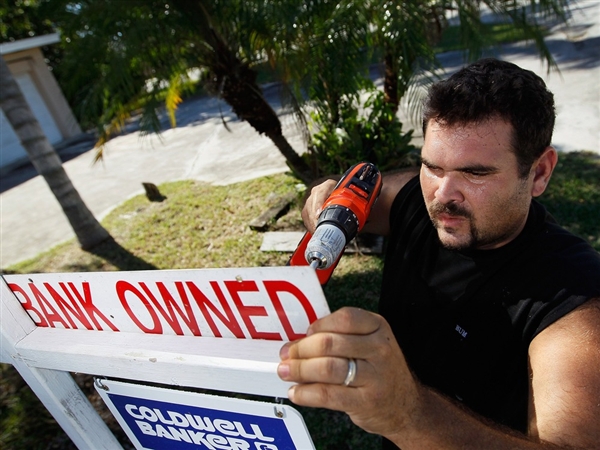If the U.S. foreclosure crisis were a baseball game, we’d probably be in the bottom of the fourth inning.
That’s roughly the message from the latest data on home foreclosures and delinquencies released by an industry association Thursday.
The pace of new home foreclosures edged up again in the third quarter and the number of borrowers falling behind on their payments eased a bit, according to the Mortgage Bankers Association. The good news was that the rate of borrowers who have fallen three or more months behind on their payments has dropped to about 3.5 percent of all mortgages. That’s down from a peak of 5 percent in late 2009. But it’s still three and a half times the “normal” rate of about 1 percent that prevailed before the mortgage meltdown hit in late 2007.
“If you look at the pace of improvement I think we’re three to four years away from the typical pattern of seriously delinquent loans,” said Michael Fratantoni, MBA’s vice president of research and economics.
Since the mortgage meltdown began in 2007, roughly six million homes have been lost to foreclosure. (Estimates vary somewhat because multiple foreclosures are often recorded on a given property as the homeowner and lender try to avoid it.) Another four million homes are estimated to be at some stage in the foreclosure process. New foreclosures are currently started at the rate of about two million a year.
That pace of new foreclosures may begin to ease more, though. The delinquency rate –- the number of borrowers who have fallen behind on their payments — fell in the third quarter to the lowest level in nearly three years. For all loans, the rate fell to 7.99 percent from 8.44 percent in the second quarter. That’s down from 9.13 percent a year ago and the lowest level since the fourth quarter of 2008.
Borrowers with subprime adjustable mortgages saw the biggest jump in new foreclosures in the third quarter. Some 4.65 percent of those subprime loans entered the foreclosure pipeline. That’s up from 3.62 percent in the second quarter, a 28 percent increase. The MBA said the rise was due in part to an increase in the number of loans that failed to get lender approval for a modification. Some states also ended their moratoriums on foreclosures during the quarter. Overall, the pace of new foreclosures for all loans edged up to 1.08 percent in the third quarter from 0.96 percent in the prior three month period. That’s down from 1.34 percent in the same period a year ago.
A lot depends on the outlook for the economy which, though showing gradual signs of improvement, is not creating jobs fast enough to put much of a dent in the unemployment rate, which is hovering at around 9 percent.
The uptick in the pace of foreclosures comes as the U.S. homebuilding industry is beginning to show a pulse three years after nearly shutting down. Though still on track this year to set a record low since 1960, when data were first collected, single family housing starts were up 3.9 percent, and permits jumped 10.9 percent. (Many economists believe permits are a better barometer of housing market strength because they are less affected less by weather and signal a pickup in future construction.)
“This was a good report,” said Patrick Newport, an economist at IHS Global Insight. “It has supporting evidence that the single-family market is finally getting off the mat.”
Continued improvement in home sales and prices, though, will depend heavily on the volume of foreclosed homes coming back on the market. Thursday’s MBA data showed that lenders have barely made a dent in the overall backlog of foreclosed homes. Since it began rising in 2007, the foreclosure inventory rate -– the percentage of loans in foreclosure -– has remained stuck at roughly 4.5 percent. That’s four and a half times the “normal” rate of about 1 percent of all homes in the foreclosure pipeline.
Not all of those homes will eventually be seized. Some foreclosures can be “cured” with a loan modification or by a homeowner catching up on missed payments. But the remainder will sit on a lender’s books until they can find a new buyer, often at a “distressed” price. Each new home that enters the foreclosure pieline becomes part of that “shadow” inventory.
“The large number of homes still in the shadow inventory will cast a cloud over the housing market and the wider economy for a few years yet,“ said Paul Dales, a senior economist at Capital Economics.
Dales figures there were something like 4.2 million homes waiting to hit the market at the end of the third quarter. As they do, they’ll continue to depress home prices, which have begun falling again after stabilizing this summer. Falling prices put more borrowers at risk of foreclosing as they burn through the remaining equity in their home and end up “underwater,” owing more than their house is worth. Some 11 million homes, or about 22 percent of all mortgaged homes, are currently underwater. Another 2.4 million have less than 5 percent equity, according to CoreLogic.
Underwater borrowers are more likely to enter a so-called “strategic” default by simply walking away from their home and no longer making mortgage payments. The rate of that default varies widely from state to state, based on both housing market conditions and state laws governing a lenders’ ability to collect the unpaid debt. Some “non-recourse” states protect homeowners from those collection efforts.
As more homeowners fall underwater, strategic default has become a bigger headache for mortgage lenders. A recent study by the MBA’s Research Institute for Housing America found that strategic defaults tend to cluster around homes already in foreclosure as friends, family and neighbors exchange advice on whether to walk away.
“It’s a concern because of the manner in which it’s become part of the public conversation,’ said Fratantoni.
Estimates of the levels of strategic default are all but impossible to make, the study found, largely because it’s very difficult to determine whether a default was truly “voluntary.” But the study found that one of the most critical variables affecting the pace of such defaults was the length of time a given home was in the foreclosure process.
The longer that process takes, the longer the idea of strategic default has to spread from one borrower to another. Today, foreclosures can take several years to play out in some parts of the country, up from historical levels of three to five months, according to the study.
The author of this article is: John W. Schoen
See the original post at: http://bottomline.msnbc.msn.com/_news/2011/11/17/8859967-foreclosure-crisis-only-about-halfway-over
At GayRealEstate.com, we keep you updated with all the gay realtor, lesbian realtor, gay realty, gay real estate and general real estate news affecting the LGBT community coast to coast, and in your neighborhood.
Click here for list of gay realtors, lesbian realtors and gay friendly realtors Nationwide.
If you have a real estate story that you’d like to share with us with the gay and lesbian real estate community, please contact us at: manager@gayrealestate.com


